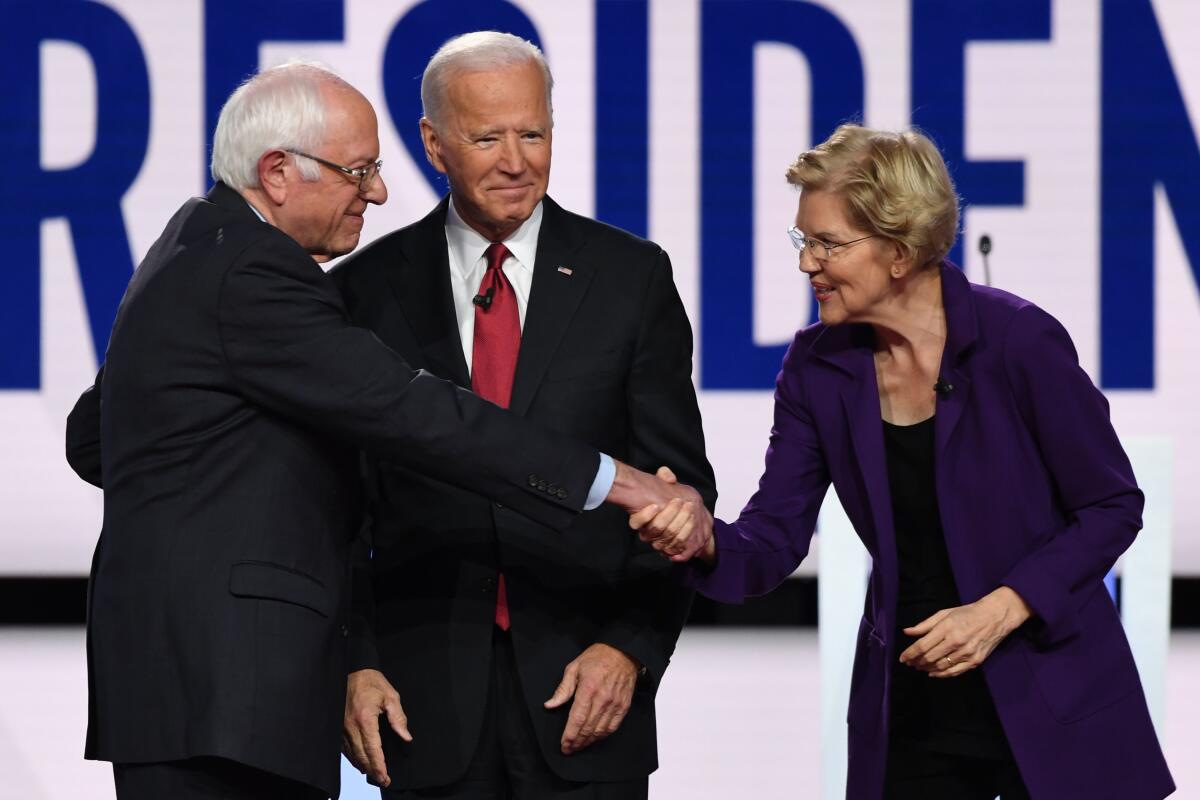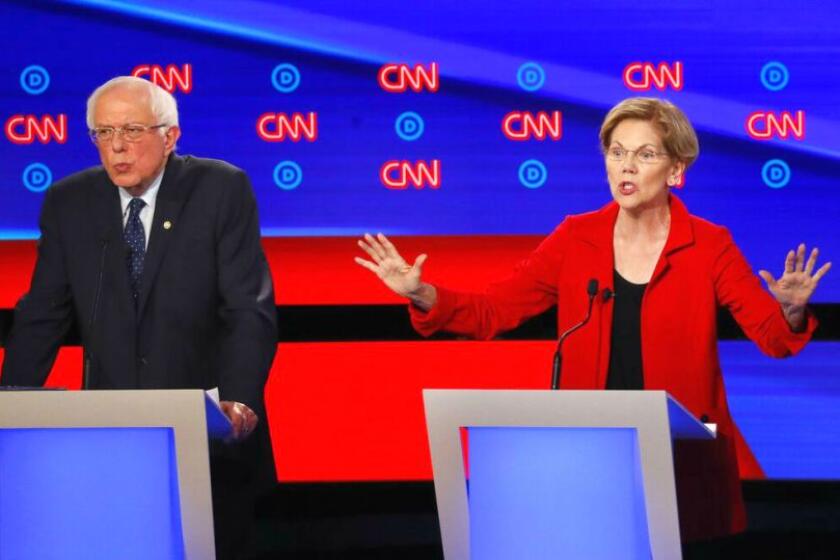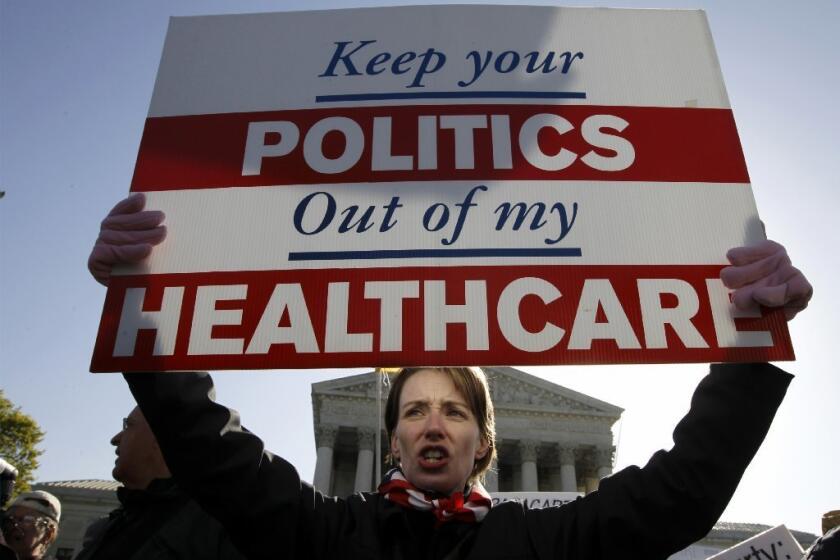An anti-deficit group tells a scary story on ‘Medicare for all,’ but is it the whole story?

- Share via
It’s Halloween week, so what better time could there be to issue an estimate of the cost of “Medicare for all” that will scare the hell out of American taxpayers?
Perhaps that’s what the Committee for a Responsible Federal Budget is thinking. On Monday, it issued a gruesome analysis of what it would take for the federal government to finance a universal healthcare program on a scale contemplated by some Democratic candidates for president (think Bernie Sanders and Elizabeth Warren).
The headline horrors to select from, according to the CRFB’s “preliminary” analysis, include these: a payroll tax increase of 32%, an income tax surtax of 25%, a 42% value-added tax (similar to a sales tax), a mandatory premium of $7,500 per person, a doubling of the national debt as a share of gross domestic product, or “impossibly high taxes on high earners, corporations, and the financial sector.” Or some combination of the above.
Most of the options we put forward are more progressive on average than current law.
— Committee for a Responsible Federal Budget
Yet, just as the frights perpetrated at your neighborhood haunted house often turn out to be not so scary after all, that’s the case with this analysis. After putting its most alarming estimates front and center, the committee acknowledges that, depending on its details, Medicare for all might even reduce total national health spending.
The committee says its main goal is to help policymakers weigh the “economic, distributional, and other consequences” of Medicare for all “relative to each other and against the effects of eliminating all premiums and out-of-pocket spending and providing comprehensive, universal health coverage through the federal government.” Among its arguments is that shifting healthcare costs from individuals and employers to government could produce headwinds for economic growth.
Patrick Newton, a committee spokesman, told me by email that “as our paper illustrates, the decision of what financing mechanism is used to replace this spending has considerable implications for the distribution of income, economic output, and the country’s tax capacity with regards to marginal rates.”
Yes, that’s important. The question is whether the committee didn’t smother that point by launching its analysis with projections of huge increases in the payroll tax and “impossibly high taxes” on corporations and the wealthy.
Before getting to the details, a few words about the Committee for a Responsible Federal Budget. It’s one of our most outspoken gaggles of fiscal hawks and was long associated with the billionaire Peter G. Peterson, who died in 2018. The Peter G. Peterson Foundation reported contributing $2.2 million to the committee April 2017- March 2018, the latest period for which a foundation disclosure is on record.
Peterson’s concerns about the federal deficit and government debt levels made him a critic of spending on “entitlement” programs such as Social Security, Medicaid and Medicare. To be fair, however, the committee is an equal-opportunity budget scold. Among its targets has been the 2017 tax cut, which went chiefly to corporations and the wealthy; just last week CRFB President Maya MacGuineas issued a full-scale denunciation of the tax cut’s drafting and fiscal consequences.
Back to Medicare for all. Conservatives sometimes have had a hard time explaining why converting America’s patchwork of profit-seeking healthcare providers and financial middlemen into a single government-supervised system would necessarily be bad. On occasion they’ve stepped on their own rake.
Private health insurers contribute nothing to healthcare except costs. It’s time to throw them out.
That happened in 2018, when the libertarian fiscal analyst Charles Blahous issued a study purporting to show that Sanders’ Medicare for all plan would result in a massive increase in federal spending.
As we pointed out, Blahous’ calculations showed that Sanders’ program would reduce national health expenditures by $2 trillion over 10 years, despite offering more Americans more healthcare services. Blahous, who wrote his paper under the auspices of the Koch-funded Mercatus Center at George Mason University, then had to spend a fair amount of energy defending his unexpected conclusion.
The fundamental sleight-of-hand in Blahous’ analysis was that it focused chiefly on how Medicare for all would affect the federal budget, without stressing that much of its impact would be a redistribution of money already being laid out by employers, families, and the federal and state budgets. That allowed him to make the cost of Medicare for all seem scarier.
The committee doesn’t go that far. Its paper reasonably observes that the first obstacle in costing out Medicare for all is defining what it is. The term is “somewhat amorphous,” the committee acknowledges, though it generally signifies universal, single-payer health insurance coverage for virtually all healthcare “with no meaningful premiums, deductibles, co-payments, or restrictive networks.”
The late Uwe Reinhardt, in a final, posthumous book, explains everything you need to know about our dysfunctional healthcare system.
The paper also acknowledges that under Medicare for all, total national healthcare spending might “increase or decrease.” Universal coverage, expanding services to cover dental or vision care, or higher utilization rates might increase costs; reducing administrative costs and cutting payments to doctors, hospitals, and drugmakers might lower them.
But the cost estimates cited by the committee don’t point to an unendurable increase in medical spending. The committee’s most dire scenario, based on an Urban Institute survey, estimates national spending at $50 trillion over 10 years, including money the federal government spends now for healthcare.
That would require $7 trillion more than estimates of current spending for 10 years (including annual inflation), or an average $700 billion per year more than is spent on healthcare now. That annual figure is the size of the military budget Congress approved last year, but instead of buying helicopters and strike fighters, it would pay for medical, dental, vision and long-term care for everyone in the country, without premiums, deductibles or co-pays.
But that’s an extreme case, which would provide all services to everyone including undocumented residents, with no premiums or cost-sharing and no private insurance allowed.
The Urban Institute, in collaboration with the Commonwealth Fund, costed out several permutations of healthcare reform that encompassed broader coverage but lower provider reimbursements and administrative costs. These included models that reduced overall spending by $209 billion in 2020 (some income-related co-pays), or $20 billion (a public option, and premium subsidies instead of elimination of premiums).
Donald Trump opened his presidency in January 2017 with a series of salvos aimed at the Affordable Care Act, the signal achievement of his predecessor’s administration.
Given the uncertainties about the details of any healthcare reform proposal, Newton’s argument that the committee is largely working out the “distributional” issues that arise when revenues from taxes are substituted for premiums and co-pays looks a bit like placing one’s thumb on the scale against Medicare for all.
That’s especially so since all the options mentioned come right out of a fiscal Grand Guignol. As the committee acknowledges, moreover, “most of the options we put forward are more progressive on average than current law.” In other words, they would hit higher-income taxpayers more than middle- or low-income Americans. That suggests who the prime audience might be for its analysis: those in the highest income tax brackets.
The committee is right to observe that every financing option has particular consequences. The committee says its “preliminary” analysis will be “followed by a more detailed analysis of the various consequences of different financing options.” That’s like rolling a bomb into a room and saying you’ll think about who might be maimed later. How long do you think it will be before Sanders or Warren is asked to justify raising the payroll tax by a third or income taxes by 25% to fund healthcare reform? And for all the concern about higher taxes suppressing economic growth, wouldn’t relieving households and businesses of the implicit tax of healthcare costs spur economic growth?
The public debate about healthcare reform in general and Medicare for all in particular is bound to be complicated, technically and politically. Putting out frightful numbers with little context is likely not to advance the debate, but to end it before it can start.
More to Read
Inside the business of entertainment
The Wide Shot brings you news, analysis and insights on everything from streaming wars to production — and what it all means for the future.
You may occasionally receive promotional content from the Los Angeles Times.














